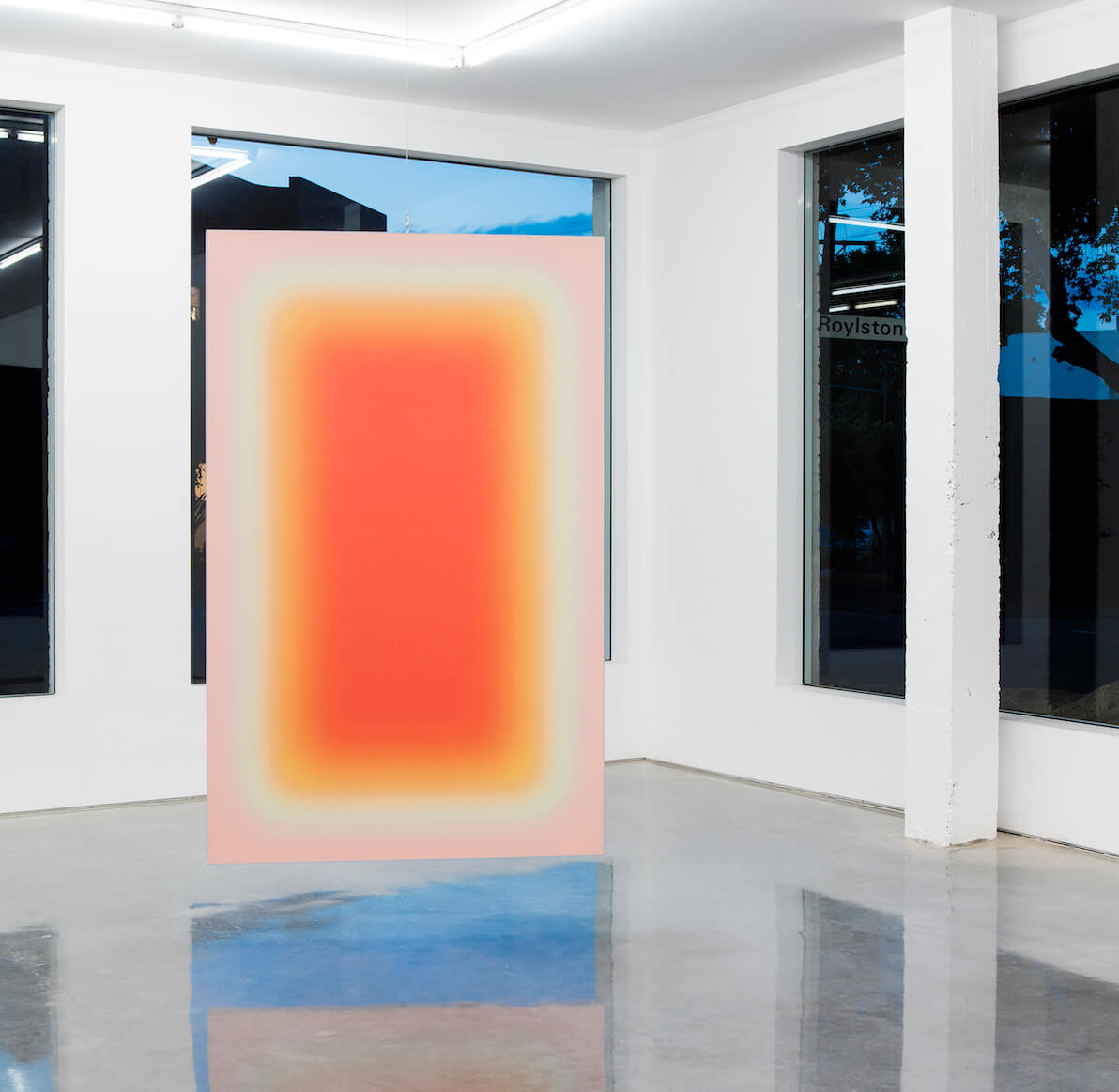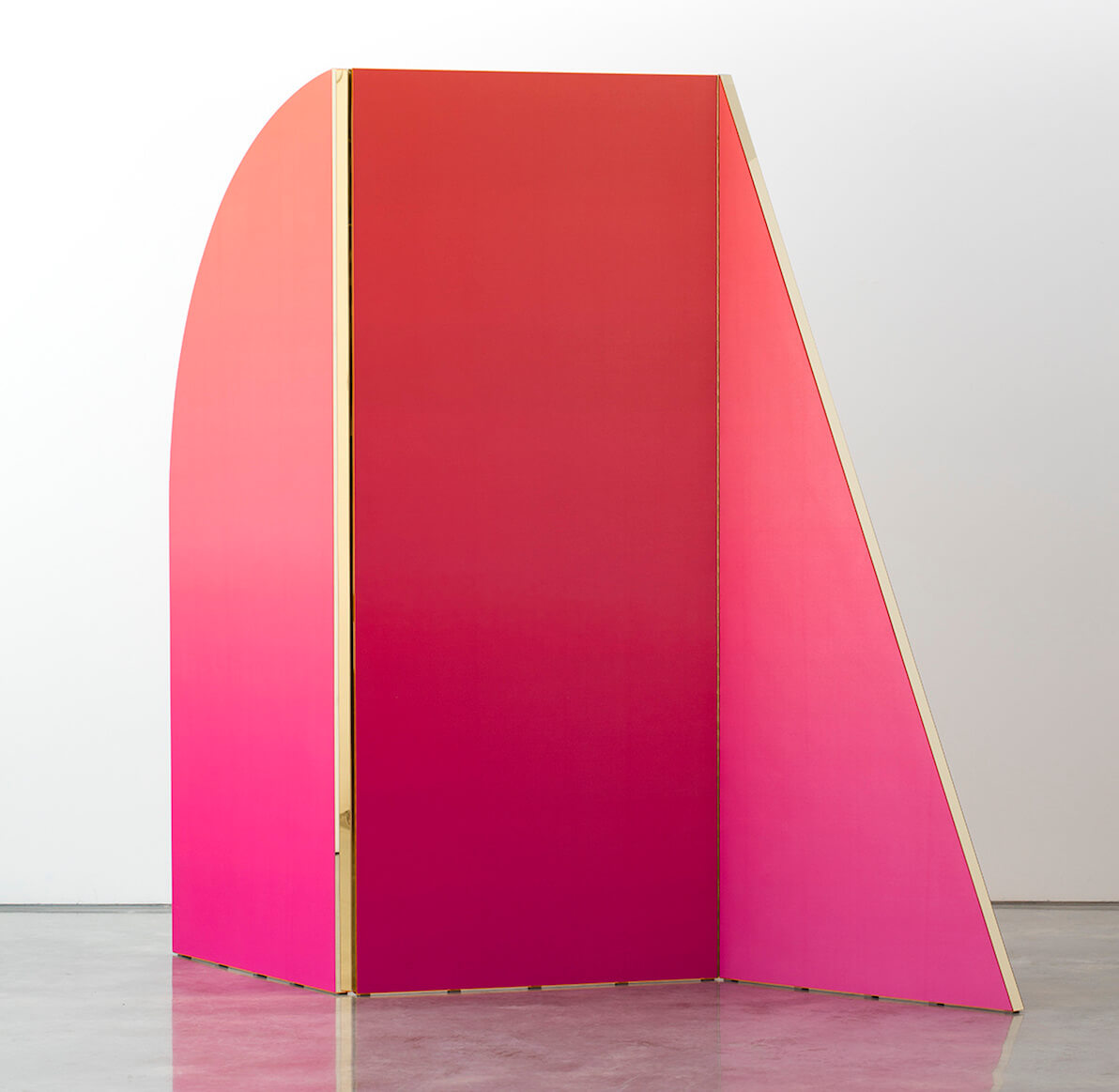Sensory Overload
Mix yourself a margarita, pop on your shades and admire a glam rock sunset as you immerse yourself in Australian artist Jonny Nieshe’s vividly coloured, sense-stimulating structures.

‘Mutual vibration’ (love light) by Jonny Niesche 2017 @ Sarah Cottier Gallery
Australian artist Jonny Niesche lures in the viewer with his rousing colourscapes full of intense pinks, blues and greens. Even browsing his images on his Instagram (@jonnyhonky) or his website (www.jonnyniesche.com) conveys some kind of atmospheric physicality that emanates beyond the screen—but visiting his works in person becomes almost immersive, as the viewer moves around and amongst his colourful 3D structures.
From his studio in West Sydney, which he shares with three friends, Jonny Niesche creates abstract works that bridge the media of painting and sculpture, featuring his signature bright hues combined with mirrors and metals. Having begun his studies at Sydney University, Jonny Niesche went on to study for a master’s under Heimo Zobernig at Vienna’s Academy of Fine Arts, which brought a European perspective to his thinking, especially from the point of view of minimalism, a huge influence on his work. Indeed, in a style that calls to mind the greats of the minimalist movement, reductive forms vibrate with the energy of vivid colours and have a seemingly sensory effect on the viewer. Jonny Niesche expands on this in reference to philosophy (with a surname like his—just a T and a Z short of Friedrich’s—it would, quite frankly, be disappointing if there weren’t some kind of philosophical reference to his work): “I am a massive fan of French philosopher Michel Serres who talks about cutting through the noise of the everyday to the primacy of our senses.”
Bold and simplified chromatic expanses draw comparisons to the colour fields of the Abstract Expressionists. “I have always been interested in the great colourists like Josef Albers, Ellsworth Kelly, Mark Rothko and also the more recent light/colour artists from California like James Turrell and Robert Irwin,” he confirms. With Jonny Niesche, gradients of neon pastels—electrically charged turquoise blues fading into striking fuchsias—conjure up an atmosphere of Miami sunsets, kitsch cocktails, and carefree, tropical warmth. Saturated tones seem to resonate, due in part to their soft-focus blurred edges as they bleed into each other in works such Mutual Vibration (Address the Body Whole) and Vertigo Effects of the Common Thread, again speaking directly to the viewer on a primary, sensory level. Jonny Niesche goes as far to explain that this very concern defines his work as an artist: “I explore the expanded field of painting and abstraction by reformulating our understanding of the effects of light and colour on the human senses.”

‘En dehors’ (scarlet to choral) by Jonny Niesche 2018 @ Sarah Cottier Gallery
Jonny Niesche’s distinctive palette also brings to mind glam rock and the flamboyant makeup of the 70s and 80s à la David Bowie and Debbie Harry. Such is the case for the highly pigmented red, blush and coral tones in the appropriately named En Dehors (Scarlet to Choral) exhibited at the Redlands Konica Minolta Art Prize earlier this year. And for Cracked Actor, Jonny Niesche’s first UK solo show that took place in London in 2017, the artist exhibited a range of man-sized articulated screens filled with tonal gradients that were taken from the cover Bowie’s album, Aladdin Sane (the fifth track of which lends its name to the exhibition title). In Picture This, a series of freestanding painting-shaped sculptures filled with rectangular fades featuring mauve, rose and orange, Jonny Niesche took colour samples from images of Debbie Harry’s hair and make-up during the 70s. “I remember as a young boy wandering around shopping with my mother in department stores in the early 80s,” Niesche reminisces. “I remember being astounded by the cosmetic departments. Mirrored surfaces everywhere, mirror polished brass and the widest selection of colours I had ever seen. This has always stayed with me. So, as a result, I took colour samples digitally to create colour palettes for some of my works.”
As recounted in this tale from his childhood, Jonny Niesche, while undeniably obsessed with colour, is also fascinated by reflective surfaces. His boldly toned forms are invariably bordered with high-shine metals, or are produced using a silk-screen type technique in which he prints onto a transparent fabric that is then stretched over acrylic mirrors. This reflective quality brings the viewer into a relationship with the work as their gaze is mirrored back to them while they contemplate the art. “I was intrigued by an interview with Bruce Nauman where he was talking about a desire like situation when you are looking in a shop window at something you want and at some point you are apprehended by your own reflection,” he reflects (pun intended), bringing up the zeitgeist topics of consumer culture and self-obsession. “I am interested in our current ‘Selfie’ obsession, our insatiable desire to look at ourselves,” he continues.
Indeed, as both reflective surfaces and three-dimensional objects, his work implicates the gallery visitor as they move around and are linked to the work, and implicates the work in the space in which it is shown. “I experiment with the effects of interactivity, involving the viewer spatially and physically in the act of looking,” Jonny Niesche explains. Some works feature sinuous outlines or are encircled with serpentine curves, while Love Knuckle is something like a cross-section of an Alvar Aalto vase in polished brass, evoking a voluptuous reclining woman in profile. Niesche explains that these rounded shapes are a reference to the human body: “I am interested in forms that suggest or insinuate the body in some way. In a gallery space this can make us aware of ourselves in the act of viewing.”
He goes on to highlight how important this three-way relationship between the art, the setting and the person contemplating it is. “I am interested in creating a visual and physiological conversation between the work, the viewer and the environment in which the work is exhibited. I had been looking at artists like Dan Graham who works a lot with translucency in his spatial architectural installations. This led me to think about experimenting with optics and exposing processes of perception. How looking through a work itself, the experience of the space, and the other viewers’ experience within the same work could be the central functioning form.”
The public will once again be able to interact with his work his forthcoming exhibitions: a solo show, Motion Picture, at the Station Gallery in Melbourne featuring scaled-up pieces; a solo show in Vienna with Zeller van Almsick Gallery, for which the artist’s first monograph will be published; and a solo show in Majorca in May at the Lundgren Gallery in Palma. But if you can’t book a ticket to any of these destinations to experience a holiday escape and a visit to these exhibitions first hand, stick an umbrella in your cocktail and feel the vibes of these sunset-like colours via your screen as you scroll through the images of his latest works on his Instagram feed.